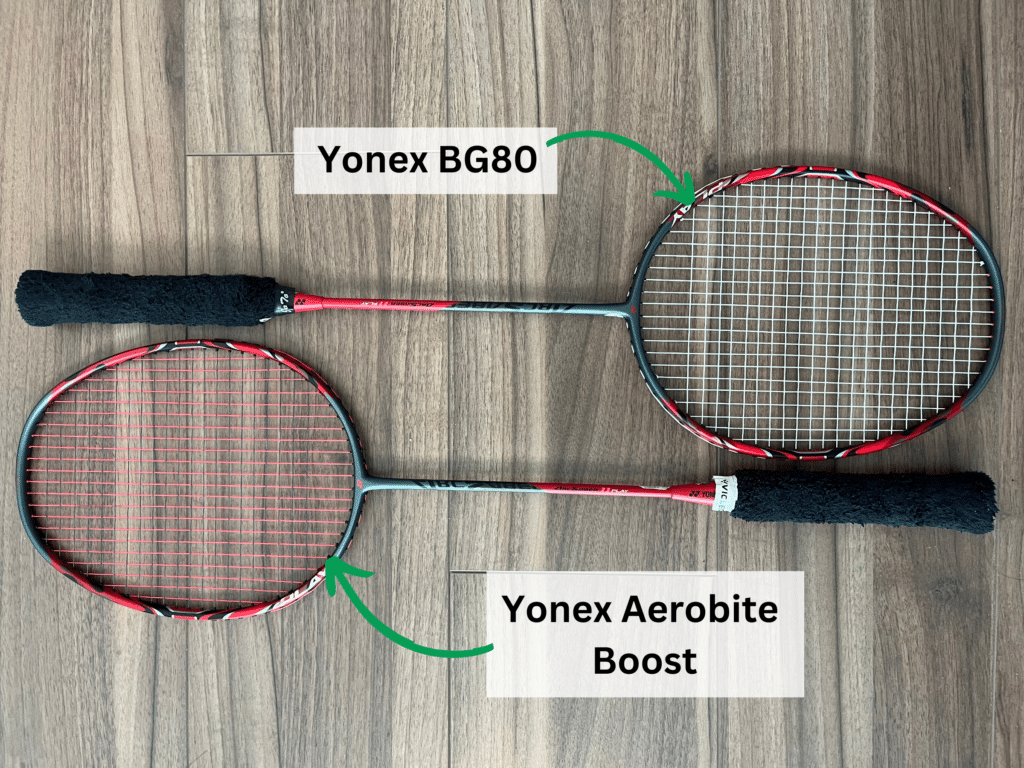Some argue that strings are even more important than your racket. I’ve been strict on playing with the same type of string during my racket reviews to keep things consistent, but now it’s time to explore how big of a difference that can have on your game for us intermediate players.
In this Yonex Aerobite Boost review, I’m exploring that string and comparing it to the popular classic Yonex BG80 string I’ve been playing with for quite some time and is used by Viktor Axelsen among others.
I don’t know much about the technical side of strings, so I’m comparing these two strings based on how different they feel for me as an intermediate player while playing. I’m sure that more skilled players will notice more nuanced differences, but I usually don’t find that as relevant since I’m not at that stage yet.
If you’re in the same boat, this Yonex Aerobite Boost review is for you.
Before we dive in, can we take a moment to appreciate how well the color of the Aerobite Boost fits my Yonex Arcsaber 11 Play?

Anyway, let’s jump in head first, starting with comparing the two categories.
Table of Contents
Yonex Aerobite Boost review
As a rule of thumb, the thinner the string is, the more skilled we need to be to take advantage of it.
Where the BG80 has a thickness of 0.68 MM, the Aerobite Boost is a hybrid string combining the Aerobite Boost at 0.72 MM and the Yonex Aerosonic string at 0.61 MM.
I didn’t know what to expect of a hybrid string going into this since it seems that one part of it should be easier to play with than the BG80, whereas the other part should make it more difficult.
Confusing, I know.
The Aerobite Boost is the thicker main string going vertically, whereas the Yonex Aerosonic with crazy repulsion is placed cross (horizontally).
The slogan for the BG80 is “overpowering heavy smash” whereas the Aerobite Boost’s slogan is “hybrid combo for powerful smash and sharp spin.” (See the packages further down.)
As we can see in Yonex’s string matrix from their 2024 catalog, the Aerosonic is Yonex’s most repulsive (powerful) string, and the Aerobite Boost has similar qualities to the BG80… although it’s categorized as a control string whereas the BG80 is categorized as a power (repulsion) string.

Are you still with me?
Then let’s compare the specs before getting on court.
String ratings and category
Comparing the stats from Yonex, I noticed that most of them are about the same with the main exception being that the Aerobite Boost is rated much higher in terms of control.
| Metrics | Yonex Aerobite Boost | Yonex BG80 |
|---|---|---|
| Quick Repulsion (Power) | 8 | 8 |
| Durability | 7 | 6 |
| Hitting Sound | 7 | 7 |
| Shock Absorption | 6 | 6 |
| Control | 10 | 6 |


With that in mind, let’s get this baby on court.
Like with shoe reviews, I’ve played with this string for ten hours on court. I used my two Yonex Arcsaber 11 Play rackets strung at 10.5 kg (23 lbs) string tension to best compare against the BG80 head-to-head.
How it felt playing with this racket
At first, I found it more difficult to get clean hits with the Aerobite Boost than with the BG80. Similar to what I experienced with the Exbolt 65, but not as bad.
It got better over time, so I imagine it just took a while to get used to the slightly different sweet spot on the Aerobite Boost string.
It felt as if I had slightly more power compared to the BG80, but less control. It became especially apparent during doubles games with fast exchanges like drive duels where you don’t always have time to get the racket placed perfectly to hit the sweet spot — it felt like me technique should be slightly better to take advantage of these situations with this string.
This is similar to the experience I had with the Exbolt 65, but with less difference so it felt like the Aerobite Boost was somewhere in the middle between the Exbolt and the BG80 for me as an intermediate player.
The repulsion (power) on defense blocks felt more fun and bouncy on the Aerobite Boost, which I like since it requires less movement of the racket during the block and it feels more like you can just put the racket on the shuttle and let physics do the work in certain situations.
I loved this when testing more head heavy rackets than the one I play with now, so it was welcomed. I also had some fun battles at the net with this string, but I’m not confident that I can attribute that to the string itself — I’m certainly not skilled at net spins as the slogan suggests it’ll help with.
Yonex Aerobite Boost: the verdict
Overall, I’m struggling to feel a major difference between these two strings in my game (which I guess is expected considering how close to each other they are on the string matrix). The Aerobite Boost felt like it had slightly more power and a slightly smaller sweet spot, despite coming across as a badminton string with more control in its marketing.
If you’re a beginner or intermediate player considering these two strings, I’d go with the Yonex BG80 as it felt like the sweet spot was slightly bigger during my tests which makes it easier to hit a clean shot if your stroke technique isn’t amazing.
I don’t have any comments in terms of durability and how well they keep their tension as I doubt I played with them enough to compare that properly.